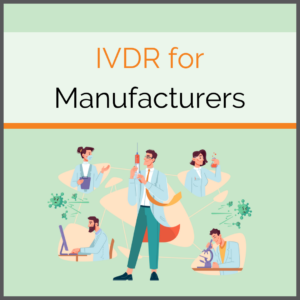
At first glance, the general differences between the In Vitro Diagnostic Directive (IVDD) and the In Vitro Diagnostic Regulation (IVDR) are not particularly significant. Regulations of the IVDD continue to exist, so to speak, but they are supplemented by additional regulations, resulting in the IVDR. For example, the obligations of economic operators, i.e., manufacturers, authorized representatives, importers, and distributors, are described in more detail. Notified bodies also receive special attention in the new regulation. In the future, they will carry out more checks on newly introduced products and monitor the market more strictly. Another significant change concerns the risk classification of in vitro diagnostic medical devices.
A fitting example is the ubiquitous SARS-CoV-2 tests. Namely, as of May 26, 2022, they fall under the highest Risk Class D. Specifically, it means that manufacturers cannot CE mark the tests themselves as before. Instead, a notified body must carry out a conformity assessment procedure beforehand so that the tests can be placed on the market. While the testing is the responsibility of the Notified Bodies, the responsibility for the product itself remains with the manufacturers. But what else do manufacturers need to know?
Risk Management
In addition to the general safety of their products, manufacturers must establish a risk management system. This covers the entire life cycle of the product. In particular, potential risks that may arise from the in vitro diagnostic product have to be determined, analyzed, and documented. The knowledge gained is then continuously updated, and the users are informed. The aim is to be able to exclude the overall risk or to minimize it as far as possible. It must therefore be possible to classify the residual risk at an acceptable level.
Technical Documentation
Another task for manufacturers in the context of the IVDR is technical documentation. According to the new regulation, it must be clearly organized, easily searchable and presented in an unambiguous form. In addition to obvious items such as product name and a description, the Basic UDI-DI is a component of the documentation. This allows users to trace the product if necessary and to obtain additional information about the manufacturer and risks. Furthermore, information is also included to demonstrate conformity. This includes basic safety and performance requirements. Verification, validation tests and/or studies that demonstrate compliance are also part of the technical documentation. This may include, for example, information on analytical performance, shelf life, and transportability.
Conformity Assessment
The IVD-Regulation requires conformity assessment based on technical documentation and additional quality management. For this, manufacturers must address all aspects of production to create processes that ensure compliance with the new regulation. This includes, among other things, a dedicated concept that enables compliance with these conformity assessment procedures. It also encloses manufacturer communication with Notified Bodies, other economic operators, and users. Also crucial is a process for determining the safety and performance of the products. These assessments may differ depending on the product. The different Risk Classes are an indicator of which conformity assessment procedure must be applied in order to be IVDR compliant as a manufacturer.
Even though the In Vitro Diagnostic Regulation puts particular focus on Notified Bodies, it does not diminish the responsibility and scope of the manufacturer on the way to compliance. Thus, users’ safety of in vitro diagnostics becomes even more relevant thanks to the changes such as the new EUDAMED. tracekey can help to achieve this compliance.
[Disclaimer]This information is only one possible interpretation of the regulations. They are also in a constant state of change, so the information in this article may be incomplete or out of date. The above article is expressly no legal advice. Please refer to the official documents for information before making any business decisions. (Status of information: December 2022)